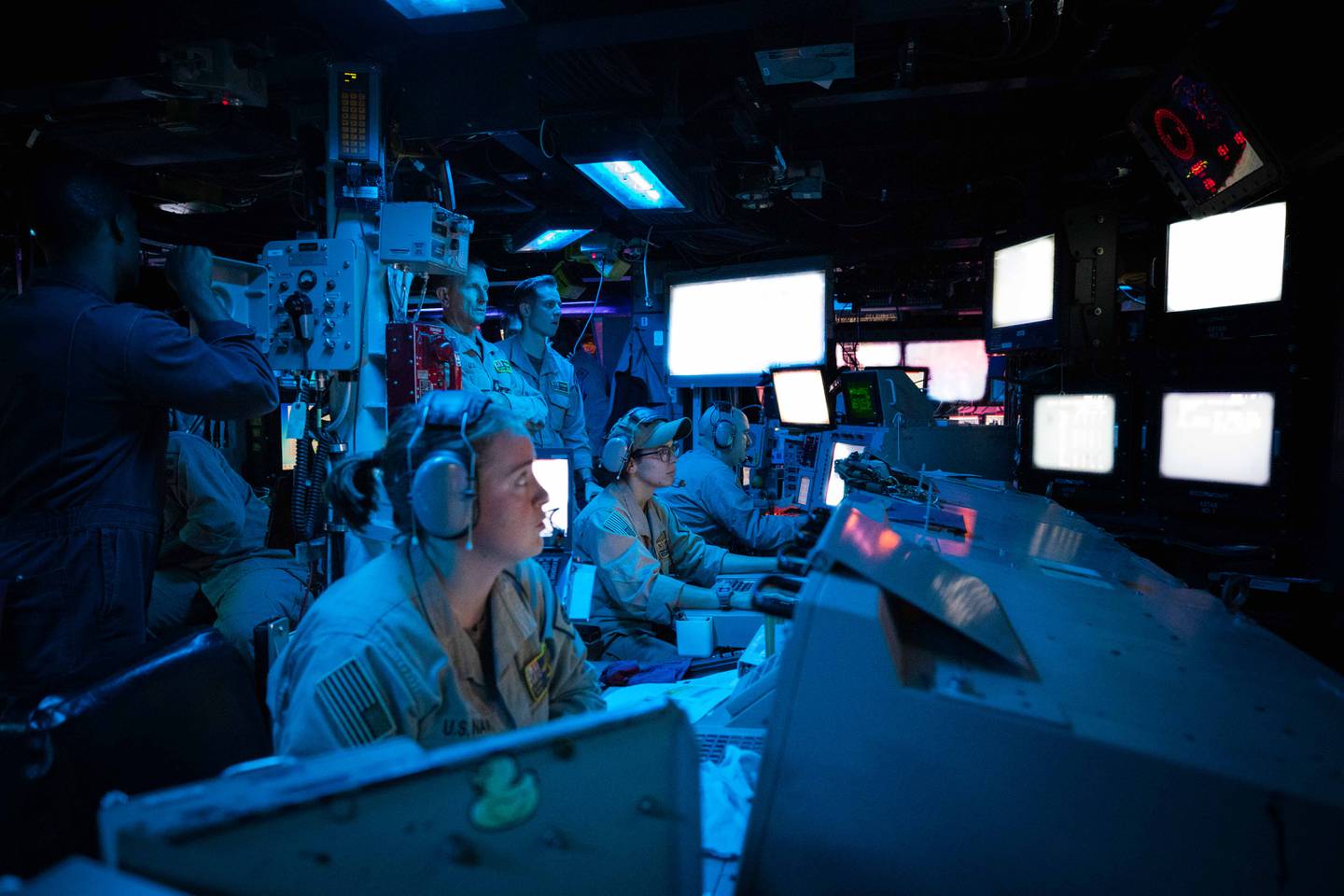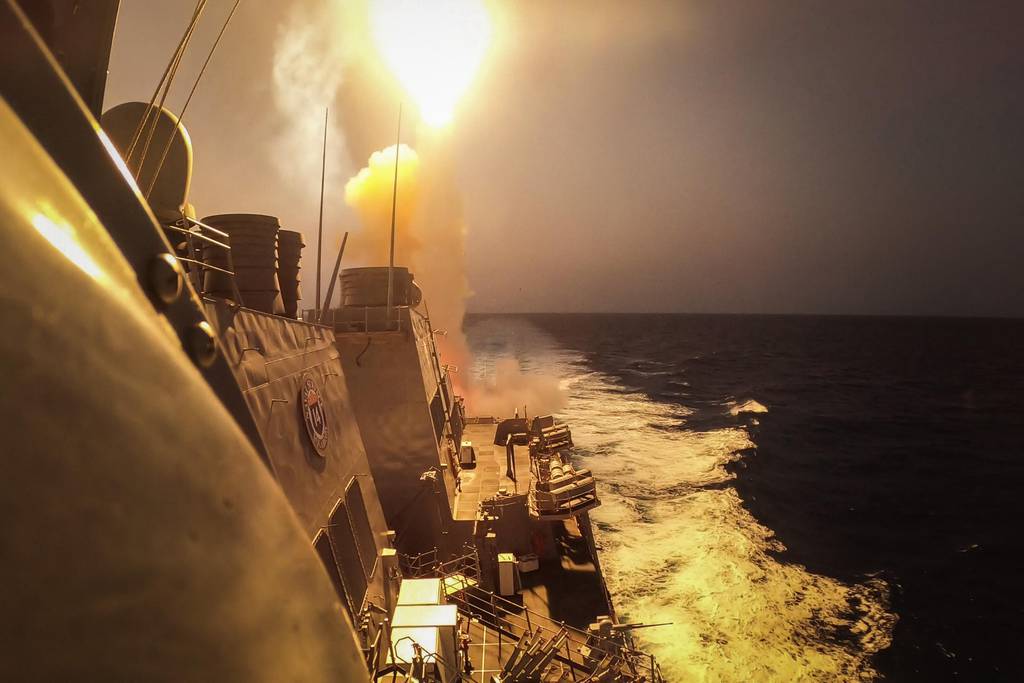The U.S. Navy and Lockheed Martin have developed and fielded software updates for destroyers shooting down Houthi missiles and drones in the Red Sea, thanks to a team of technical experts that mined data from all the shootdown events since October.
The team studied engagements between U.S. ships and aircraft in the Middle East as well as threats posed by the Yemen-based militant group to understand how the fleet could tweak operations to better see and defeat drones and missiles. It also considered new capabilities the fleet might need for self-defense and to protect merchant ships.
The Naval Surface and Mine Warfighting Development Center has led this effort. The center’s mission is to develop surface warfare tactics, incorporate those into advanced training events and provide tactical expertise for the fleet.
The center’s commander, Rear Adm. Wilson Marks, told Defense News that after the Arleigh Burke-class destroyer Carney’s Oct. 19 shootdown of three land-attack cruise missiles launched from Yemen, “we did stand up a 24/7 watch to ensure that we could provide support to the ships and staff at a moment’s notice as they needed.”
As engagements lessened, the Navy has moved into a steady-state rhythm, with weekly meetings involving SMWDC, ships’ crew members, strike group leaders, U.S. 5th Fleet leaders and more.
The ships and aircraft provide a “storyboard” of what happened in each engagement from their perspective, Marks said, as well as data collected by the radars, sensors and combat systems.
SMWDC’s technical experts in Dahlgren, Virginia, then work with a team that includes Program Executive Office Integrated Weapons Systems, Naval Surface Warfare Center Dahlgren Division, Naval Surface Warfare Center Corona Division, Naval Information Warfighting Development Center, Johns Hopkins Applied Physics Laboratory and Lockheed Martin — and they scour the data for a range of purposes.
“The first thing is we provide immediate feedback to the ships,” highlighting any tactics changes SMWDC recommends, anything new they’re seeing in adversary behavior, new ways to configure ship systems to better see and respond to the threat, or other urgent lessons.
“Basically we’re trying to pull away the fog of war that’s going on there,” Marks said.

In parallel, PEO Integrated Weapons Systems and Lockheed Martin are looking for “potential technical fixes” that can go into Aegis Combat System updates.
Additionally, SMWDC not only provides briefings about lessons learned to the next ships preparing to deploy, but it also rolls these updated tactics and real-world scenarios into the Surface Warfare Advanced Tactical Training events that ships conduct before their final certifications and deployments.
The Abraham Lincoln Carrier Strike Group, for example, went through a Surface Warfare Advanced Tactical Training event that was heavily influenced by the types of engagements destroyers have seen in the Red Sea over the past six months.
The strike group also tested tweaks to the Aegis Combat System software before it was pushed to ships currently operating in the Middle East, Marks said. He would not discuss the nature of the software changes, citing security reasons, but said it has shown “a significant increase in capability.”
Marks said the Navy and Lockheed Martin had developed a so-called Aegis Speed to Capability process that allows for small changes to be rapidly fielded, instead of waiting to incorporate them into the next major baseline upgrade to the combat system software.
The rear admiral said this has proved its value, as some ships deployed to the region now have software updates that help counter drones, “and we’re finding those to be very successful. And so that was an investment that was made several years ago that is really paying off now.”
Broadly, Marks said, Houthi engagements since October show the “tactics, techniques and procedures that we have in place are solid. Any changes that need to be made to those are kind of in the margins, and basically just making sure people fully understand how to utilize them.”
Though he wouldn’t provide specifics, again citing security reasons, Marks said some lessons learned have to do with the basics, including how the crews set up and operate their SPY radar.
“The Red Sea is probably one of the most difficult areas of the world when it comes to atmospherics and issues with radars. So our continued emphasis on how you set up your radar system in that type of environment has really been critical,” he said. “The second is, because of those atmospheric conditions, and also based on the adversary they’re going against, we make sure that we tailor our systems to look for the capabilities that the adversary has.”
Rather than look for a missile or drone akin to what China and Russia might fire, “you would look at the current adversary and say: ‘Hey, maybe we need to focus in a little bit more on ... certain speed characteristics or things like that that they’re seeing over in the Red Sea.’”

He noted SMWDC made a decision within the past couple years to add training on countering unmanned systems in all domains, which has been validated by Houthis operating unmanned systems in the air, on the surface and under the water.
Overall, he said, the Surface Warfare Advanced Tactical Training events and other drills don’t require major changes or additions; rather, they may be tweaked to add a little more emphasis on certain skills and types of engagements to best prepare deploying ships for what they could encounter in the Middle East.
Though SMWDC and the rest of the technical team have generated a number of lessons and changes since October, Marks said it is important to note “our captains and crews in the Red Sea have been doing an absolutely incredible job.”
“Those sailors are executing at the top of their game — and this is during sustained combat operations at sea — and they’ve been adapting to all the adversary’s tactics like true combat veterans,” he added.
Megan Eckstein is the naval warfare reporter at Defense News. She has covered military news since 2009, with a focus on U.S. Navy and Marine Corps operations, acquisition programs and budgets. She has reported from four geographic fleets and is happiest when she’s filing stories from a ship. Megan is a University of Maryland alumna.








